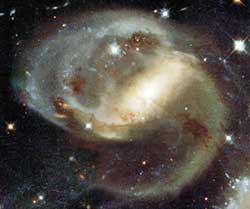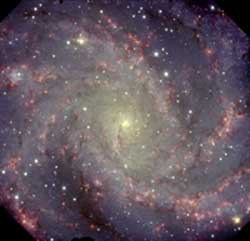This area deals with the fundamental laws and building blocks of nature and how they interact, the properties and the behavior of matter, and research into space and time and their structures.
innovations-report provides in-depth reports and articles on subjects such as astrophysics, laser technologies, nuclear, quantum, particle and solid-state physics, nanotechnologies, planetary research and findings (Mars, Venus) and developments related to the Hubble Telescope.

When our solar system was young, its biggest babies–Jupiter and Saturn–threw tantrums by the trillion. The huge planets hurled ice-covered rocky bodies from the inner solar system far past the orbit of Pluto. Some of those bodies revisit their old neighborhood as “long period” comets, which have been called the Rosetta Stone of the solar system because their pristine composition holds the key to understanding how Earth and similar planets formed. Astrophysicists from the University of Minne

In the largest galaxy survey ever, the Sloan Digital Sky Survey (SDSS) confirmed the role of gravity in growing structures in the universe, using the result to precisely measure the geometry of the universe.
The SDSS researchers from the University of Arizona, New York University, the University of Portsmouth (UK), the University of Pittsburgh and the Massachusetts Institute of Technology, detected ripples in the galaxy distribution made by sound waves generated soon after the Bi

Unique follow up observations carried out with the NASA/ESA Hubble Space Telescope are providing important supporting evidence for the existence of a candidate planetary companion to a relatively bright young brown dwarf star located 225 light-years away in the southern constellation Hydra.
Astronomers at the European Southern Observatory’s Very Large Telescope (VLT) in Chile detected a planet candidate in April 2004 with infrared observations using adaptive optics to sharpen th

An international team of astronomers has discovered within the heart of a nearby spiral galaxy a quasar whose light spectrum indicates that it is billions of light years away. The finding poses a cosmic puzzle: How could a galaxy 300 million light years away contain a stellar object several billion light years away?
The team’s findings, which were presented today in San Diego at the January meeting of the American Astronomical Society and which will appear in the February 10 issue

To celebrate the New Year – and to mark the formal debut of its online Image Gallery – the Gemini Observatory has released three striking new images.
The first, taken by the Gemini North telescope atop Mauna Kea on the big island of Hawaii, was made public on New Year’s Eve, 2004, and shows the face-on spiral galaxy NGC 6946 ablaze with galactic fireworks. Each explosion of pink is a region of active star formation, where the fierce light of newborn stars is exciting the sur

A swarm of 10,000 or more black holes may be orbiting the Milky Way’s supermassive black hole, according to new results from NASA’s Chandra X-ray Observatory. This would represent the highest concentration of black holes anywhere in the Galaxy.
These relatively small, stellar-mass black holes, along with neutron stars, appear to have migrated into the Galactic Center over the course of several billion years. Such a dense stellar graveyard has been predicted for years,